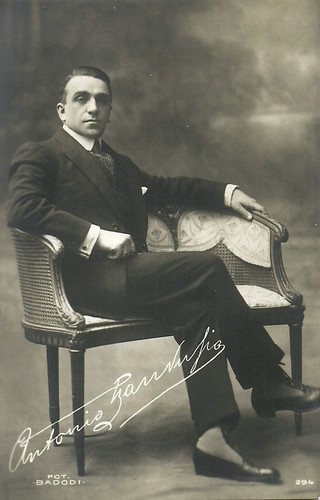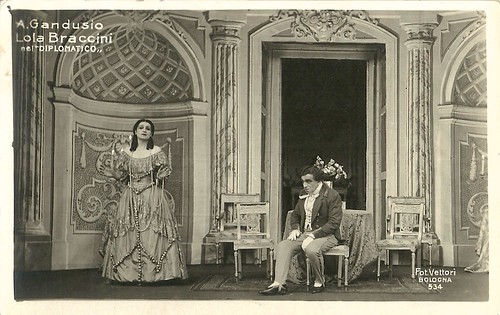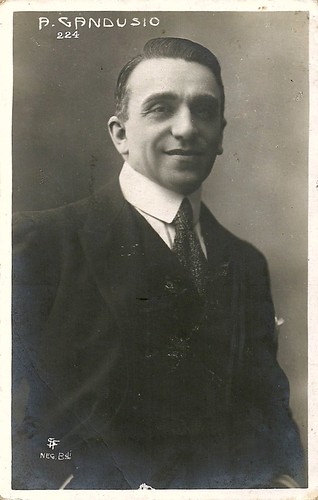Antonio Gandusio (1873-1951) was one of the most famous comic actors of the twentieth-century theatre. He also had a rich career in the 1930s and 1940s Italian cinema. Gandusio appeared in 34 films between 1914 and 1948.

Italian postcard, no. 294. Photo: Badodi.

Italian postcard by Ed. A. Traldi, Milano, no. 32. Photo: Badodi, Milano.

Italian postcard by ASER (A. Scarmiglia Edizioni Roma), no. 299. Photo: Vaselli / Lux Film. 1940s.
Antonio Gandusio was born in 1873 in Rovigno d'Istria, what was then still Austro-Hungarian Istria, now Rovin, Croatia. He went to law studies pushed by his father, a lawyer. He graduated studying first in Genoa and then in Rome, where he cultivated his passion for acting.
It prompted him to study at a theatre school and, subsequently, to find engagements at some of the most renowned theatre companies of the time. In 1899 he obtained an engagement with Alfredo De Sanctis.
After that, he began long collaborations with the companies of Irma Gramatica, Flavio Andò, Evelina Paoli, Lyda Borelli, Ugo Piperno, Virgilio Talli, Maria Melato, and Annibale Betrone. He obtained the opportunity to work with actors of the calibre of Tina Di Lorenzo, Sergio Tofano and Uberto Palmarini.
His physical characteristics, a graceless voice, a slight hump, and an irregular face, made him suitable for the role of a comedian. In the wake of his family's tradition of 'Irredentismo', which had historically provided captains to the Republic of Venice, he refused to join their army after the outbreak of the First World War. Therefore, he was sentenced to death by the Austrian military court in 1915. He stayed in Italy and survived.
In 1918, he became the leader of a theatre company, staging a repertoire based mainly on 'pochades' and farces. Among the various productions, however, were also those of the plays by Luigi Pirandello, of which Gandusio was a sensitive interpreter. The managerial activity led him to become an interpreter of part of the new Italian dramaturgy represented by the work of Luigi Chiarelli and Luigi Pirandello. As a manager, he had the opportunity to direct actors such as Paolo Stoppa, Nico Pepe, and Nando Gazzolo.

Italian postcard, no. 534. Photo: Vettori, Bologna. Lola Braccini and Antonio Gandusio in the play 'Il Diplomatico'.

Italian postcard by Vettori, Bologna. Photo: Rinasciento Film. Pina Menichelli, Luigi Serventi and Antonio Gandusio in Il romanzo di un giovane povero/The Story of a Poor Young Man (Amleto Palermi, 1920), based on the novel 'Le Roman d'un jeune homme pauvre' (1858) by Octave Feuillet.

Italian postcard by Ed. Vettori Bologna, no. 1052. Pina Menichelli, Luigi Serventi, Gustavo Salvini and Antonio Gandusio in Il romanzo di un giovane povero/The Story of a Poor Young Man (Amleto Palermi, 1920), based on the novel 'Le Roman d'un jeune homme pauvre' (1858) by Octave Feuillet. The proud Margherita (Menichelli), daughter of the rich Laroque (Salvini), falls in love with her father's administrator, Massimo Odiot (Serventi), but fears he is only after her money. The real vulture, however, is a corrupt count (Gandusio), to whom Margharita is betrothed, unknowing of the man's plans. When Massimo and Margherita are accidentally locked into an old tower, Massimo sacrifices himself and jumps to get help. When afterwards he gets hold of a fortune, nothing can prevent the marriage between the two anymore.
In the silent era, Antonio Gandusio had three scarce, supporting roles in Rinunzia (Carmine Gallone, 1914) starring Soava Gallone, Strana (Alfredo Robert, 1917), and Il romanzo di un giovane povero/The Story of a Poor Young Man (Amleto Palermi, 1920) starring Pina Menichelli, and Luigi Serventi.
From the early 1930s, Gandusio's film acting career really set off when sound had set in. He peaked in the later 1930s with such films as L'albero di Adamo/Adam's Tree (Mario Bonnard, 1938) based on a play by Alfredo Testoni, the comedy Per uomini soli/For Men Only (Guido Brignone, 1938), the romantic comedy Eravamo 7 sorelle/We Were Seven Sisters (Nunzio Malasomma, 1939), Eravamo sette vedove/We Were Seven Widows (Mario Mattoli, 1939), and the comedy Frenesia/Frenzy (Mario Bonnard, 1939) with Dina Galli.
In all these films, Gandusio played the lead or at least the male lead opposite such actresses as Elsa Merlini and Betty Stockfeld. Or he was the second man of films like Cose dell'altro mondo (Nunzio Malasomma, 1939). During the war years, Gandusio's film career remained high with his leads in Manovre d'amore/Maneuvers of Love (Gennaro Righelli, 1940), Se non son matti non li vogliamo/If They Are Not Crazy, We Don't Want Them (Esodo Pratelli, 1941), and Le signorine della villa accanto/The Ladies of the Villa Next Door (Gian Paolo Rosmino, 1942).
Well-known films of the 1940s in which Gandusio had major parts were Stasera niente di nuovo/Nothing New Tonight (Mario Mattoli, 1942) with Alida Valli, and La vispa Teresa/Lively Teresa (Mario Mattoli, 1943) with Lilia Silvi.
After the war, Gandusio still acted in a handful of films, including the drama Lo sconosciuto di San Marino/The Unknown Man of San Marino (Michał Waszyński, 1948) with Vittorio De Sica. He stopped acting after 1948. Antonio Gandusio passed away in 1951 in Milan. He was 75. In his hometown, the city theatre took his name.

Italian postcard.

Italian postcard by SIF. Photo: Badodi.

Italian postcard. Photo: Badodi, Milano. Antonio Gandusio in the play 'Baciatemi' by Bernard, Mirande and Quinson, Teatro Goldoni, 9 May 1927, "Serata in Onore di Antonio Gandusio". Other actors in the play were a.o. Giacomo Almirante, Olinto Cristina, Enrico Viarisio and Lola Braccini. All had subsequent film careers in the 1930s and 1940s.
Sources: Wikipedia (Italian and English), and IMDb.
This post was last updated on 1 May 2024.

Italian postcard, no. 294. Photo: Badodi.

Italian postcard by Ed. A. Traldi, Milano, no. 32. Photo: Badodi, Milano.

Italian postcard by ASER (A. Scarmiglia Edizioni Roma), no. 299. Photo: Vaselli / Lux Film. 1940s.
A graceless voice, a slight hump, and an irregular face
Antonio Gandusio was born in 1873 in Rovigno d'Istria, what was then still Austro-Hungarian Istria, now Rovin, Croatia. He went to law studies pushed by his father, a lawyer. He graduated studying first in Genoa and then in Rome, where he cultivated his passion for acting.
It prompted him to study at a theatre school and, subsequently, to find engagements at some of the most renowned theatre companies of the time. In 1899 he obtained an engagement with Alfredo De Sanctis.
After that, he began long collaborations with the companies of Irma Gramatica, Flavio Andò, Evelina Paoli, Lyda Borelli, Ugo Piperno, Virgilio Talli, Maria Melato, and Annibale Betrone. He obtained the opportunity to work with actors of the calibre of Tina Di Lorenzo, Sergio Tofano and Uberto Palmarini.
His physical characteristics, a graceless voice, a slight hump, and an irregular face, made him suitable for the role of a comedian. In the wake of his family's tradition of 'Irredentismo', which had historically provided captains to the Republic of Venice, he refused to join their army after the outbreak of the First World War. Therefore, he was sentenced to death by the Austrian military court in 1915. He stayed in Italy and survived.
In 1918, he became the leader of a theatre company, staging a repertoire based mainly on 'pochades' and farces. Among the various productions, however, were also those of the plays by Luigi Pirandello, of which Gandusio was a sensitive interpreter. The managerial activity led him to become an interpreter of part of the new Italian dramaturgy represented by the work of Luigi Chiarelli and Luigi Pirandello. As a manager, he had the opportunity to direct actors such as Paolo Stoppa, Nico Pepe, and Nando Gazzolo.

Italian postcard, no. 534. Photo: Vettori, Bologna. Lola Braccini and Antonio Gandusio in the play 'Il Diplomatico'.

Italian postcard by Vettori, Bologna. Photo: Rinasciento Film. Pina Menichelli, Luigi Serventi and Antonio Gandusio in Il romanzo di un giovane povero/The Story of a Poor Young Man (Amleto Palermi, 1920), based on the novel 'Le Roman d'un jeune homme pauvre' (1858) by Octave Feuillet.

Italian postcard by Ed. Vettori Bologna, no. 1052. Pina Menichelli, Luigi Serventi, Gustavo Salvini and Antonio Gandusio in Il romanzo di un giovane povero/The Story of a Poor Young Man (Amleto Palermi, 1920), based on the novel 'Le Roman d'un jeune homme pauvre' (1858) by Octave Feuillet. The proud Margherita (Menichelli), daughter of the rich Laroque (Salvini), falls in love with her father's administrator, Massimo Odiot (Serventi), but fears he is only after her money. The real vulture, however, is a corrupt count (Gandusio), to whom Margharita is betrothed, unknowing of the man's plans. When Massimo and Margherita are accidentally locked into an old tower, Massimo sacrifices himself and jumps to get help. When afterwards he gets hold of a fortune, nothing can prevent the marriage between the two anymore.
Peaking in the late 1930s
In the silent era, Antonio Gandusio had three scarce, supporting roles in Rinunzia (Carmine Gallone, 1914) starring Soava Gallone, Strana (Alfredo Robert, 1917), and Il romanzo di un giovane povero/The Story of a Poor Young Man (Amleto Palermi, 1920) starring Pina Menichelli, and Luigi Serventi.
From the early 1930s, Gandusio's film acting career really set off when sound had set in. He peaked in the later 1930s with such films as L'albero di Adamo/Adam's Tree (Mario Bonnard, 1938) based on a play by Alfredo Testoni, the comedy Per uomini soli/For Men Only (Guido Brignone, 1938), the romantic comedy Eravamo 7 sorelle/We Were Seven Sisters (Nunzio Malasomma, 1939), Eravamo sette vedove/We Were Seven Widows (Mario Mattoli, 1939), and the comedy Frenesia/Frenzy (Mario Bonnard, 1939) with Dina Galli.
In all these films, Gandusio played the lead or at least the male lead opposite such actresses as Elsa Merlini and Betty Stockfeld. Or he was the second man of films like Cose dell'altro mondo (Nunzio Malasomma, 1939). During the war years, Gandusio's film career remained high with his leads in Manovre d'amore/Maneuvers of Love (Gennaro Righelli, 1940), Se non son matti non li vogliamo/If They Are Not Crazy, We Don't Want Them (Esodo Pratelli, 1941), and Le signorine della villa accanto/The Ladies of the Villa Next Door (Gian Paolo Rosmino, 1942).
Well-known films of the 1940s in which Gandusio had major parts were Stasera niente di nuovo/Nothing New Tonight (Mario Mattoli, 1942) with Alida Valli, and La vispa Teresa/Lively Teresa (Mario Mattoli, 1943) with Lilia Silvi.
After the war, Gandusio still acted in a handful of films, including the drama Lo sconosciuto di San Marino/The Unknown Man of San Marino (Michał Waszyński, 1948) with Vittorio De Sica. He stopped acting after 1948. Antonio Gandusio passed away in 1951 in Milan. He was 75. In his hometown, the city theatre took his name.

Italian postcard.

Italian postcard by SIF. Photo: Badodi.

Italian postcard. Photo: Badodi, Milano. Antonio Gandusio in the play 'Baciatemi' by Bernard, Mirande and Quinson, Teatro Goldoni, 9 May 1927, "Serata in Onore di Antonio Gandusio". Other actors in the play were a.o. Giacomo Almirante, Olinto Cristina, Enrico Viarisio and Lola Braccini. All had subsequent film careers in the 1930s and 1940s.
Sources: Wikipedia (Italian and English), and IMDb.
This post was last updated on 1 May 2024.
No comments:
Post a Comment